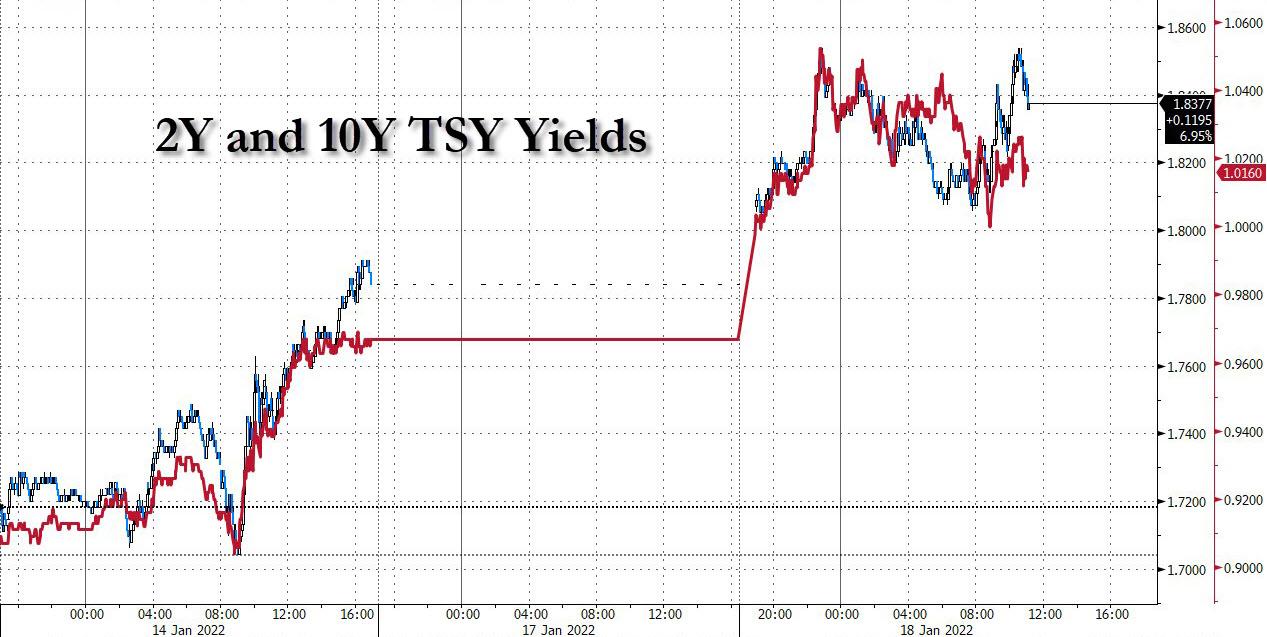As Treasury Yields Soar, Here Is What Wall Street Thinks Happens To Interest Rates Next
The relentless selling in rates has resumed after Monday's US holiday, with violent bear-flattening in UST curves (although off worst levels now), as our belief that an aggressive Fed tightening will coincide with lower long-term growth spreads across trading desks, and as the front-end succumbs to another blistering escalation of FOMC hiking expectations (which according to Nomura's Charlie McElligott earlier priced a touch over four hikes in ’22, up from 3.5x’s just mid- / late- last week), while Brent Crude surges to fresh 8 year highs, and European Gas Prices again jump higher on Ukraine / Russia geopolitical stress (also crunching EM Bond funds, where Ukraine has been a popular “long”).
And so with the yield juggernaut seemingly unstoppable, at least until the slowdown/recession narrative becomes dominant (and today's dismal Empire Fed print is a big first step on the way there), and the 10Y rising just shy of 1.86%...
(Click on image to enlarge)

... here is what Wall Street's most prominent rates strategists write in their latest research reports, in which we finds several seeing potential for near-term consolidation based on factors including slowing inflation, dip-buying and hedging for stock market weakness (courtesy of Bloomberg).
Bank of America (Mark Cabana, others, Jan. 14 report)
- Last week’s “Fed hawk shock” warrants trading the new higher rate range “with a bearish duration + curve flattening bias”
- Has pulled forward expectation for QT announcement to June, with monthly caps of $60b for UST, $40b for MBS
- Recommends positioning for a flatter 5s30s real curve, partly based on potential for partial reversal of last year’s ETF inflows and for Treasury to cut only nominal supply
Barclays (Anshul Pradhan, others, Jan. 14 report)
- Maintains “there is limited room for a further sell-off and that rates will be range-bound” because “the upward pressure on term premium at the long end from a gradual/predictable increase in supply is likely to be modest”
- Expected path of terminal policy rate “will largely be determined by the inflation outlook,” which “is expected to quickly decline to the Fed’s 2% target”
- Recommends trades “that would benefit from the onset of the hiking cycle,” including receiving belly of 5s10s30s SOFR fly and 2yf 10s30s steepeners
Deutsche Bank (Steven Zeng, Jan. 14 report)
- “Based the rate movement in January so far, we think only a small fraction of the anticipated QT effect is priced by the market,” as “most of the long-dated yield increases appear to be driven by higher front-end expectations and not related to tightening concerns of the Fed’s balance sheet policy”
- Still, another steep selloff in very near term could be averted if buyers emerge for the highest yields in years, as well as for Treasuries as an insurance hedge for stock market weakness
- Maintains recommendations to be short the 10-year note and holding beta-hedged 5s10s steepeners
Goldman Sachs (Praveen Korapaty, others, Jan. 14 report)
- Market-implied Fed path is “still skewed towards SEP meetings, though less dramatically so than last cycle”
- “While not in our base case, in the event the market starts to consider the risk of more than four hikes per year, the perception of non-SEP meetings as more ‘live’ than last time could support such a shift”
Morgan Stanley (Guneet Dhingra, others, Jan. 15 report)
- Government bonds are “not yet” a buy
- “The repricing of duration to start 2022 signals risk of higher yields ahead,” as “too many central banks are on the move or sending signals, rendering traditional cross-market valuation metrics less reliable”
- An early start to Fed QT “will steepen the yield curve,and open the door to more rate hikes over the cycle -- not fewer -- raising the terminal rate the Fed could achieve”; market could price for 8 hikes
- Favors trades “that play for an underperformance of the belly of the yield curve,” especially the 5-year, based on “a repricing of the Treasury supply path” in addition to the terminal rate
- Revises end-2022 Treasury yield forecasts; 10-year to 2.30%, 2-year to 1.60%., real 10-year to -0.10%
Soc Gen (Subadra Rajappa, others, Jan. 13 report)
- “We see more room for yields to rise, although the path to higher yields is likely in stages”
- Fed should use a combination of rate hikes and quantitative tightening to remove accommodation “given the size of the balance sheet and the flatness of the curve”
- Favors UST 2s10s steepener as a positive carry short duration proxy, and short U.S. 10-year vs German “as Treasuries are likely to continue to underperform in a sell-off owing to asynchronous central bank policy outcomes”
TD (Priya Misra, others, Jan. 14 report)
- Has pulled forward expectations for Fed policy shift; expects March rate hike and September start of balance-sheet runoff
- “We continue to expect three hikes this year, however, and believe that the market’s pricing for nearly four full hikes remains a bit aggressive” as virus developments may temper the recovery; accordingly favors long UST 2-year in near term
- End-2022 forecast for 10-year is increased to 2.25%; favors short position in 10-year real rate targeting -60bp in near term, -25bp at year-end
- Flattening in 5s30s “has been a function of more hikes getting priced into the front end. Once the market prices in a terminal rate of 2%, we think the long end will become more vulnerable to selloffs due to balance sheet runoff”
- “Thus, we lean towards steepeners, but are waiting for the front end to finish repricing before entering into the position”
Source: Bloomberg
Disclaimer: Copyright ©2009-2022 ZeroHedge.com/ABC Media, LTD; All Rights Reserved. Zero Hedge is intended for Mature Audiences. Familiarize yourself with our legal and use policies ...
more


